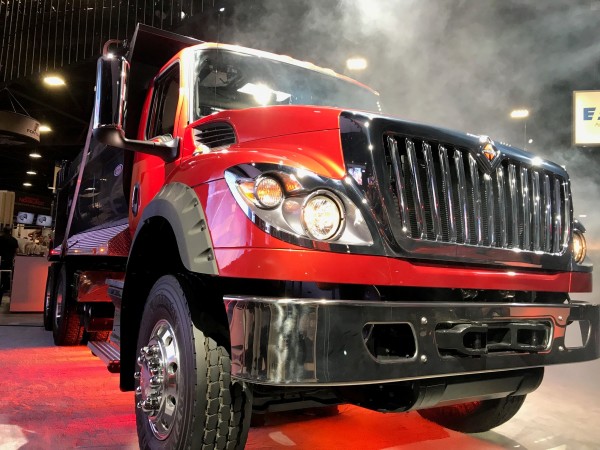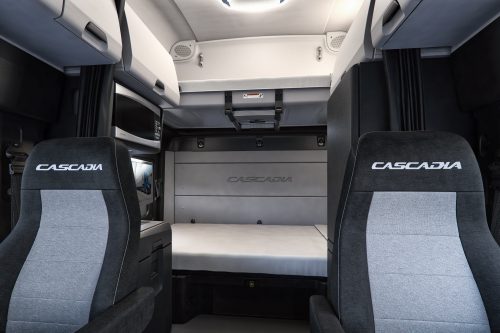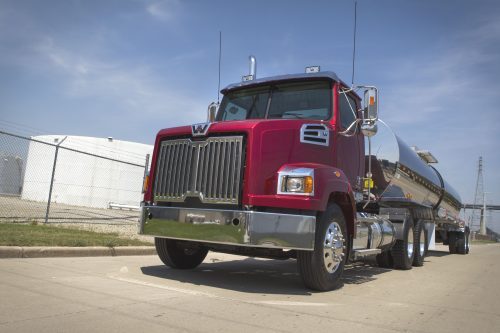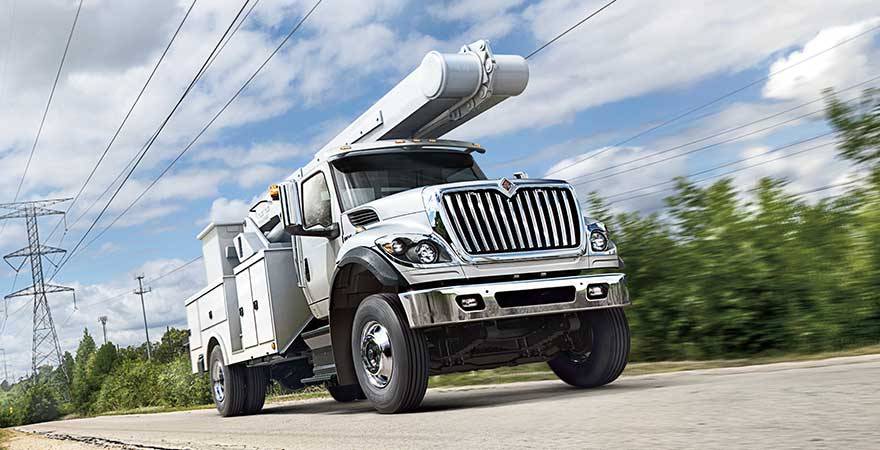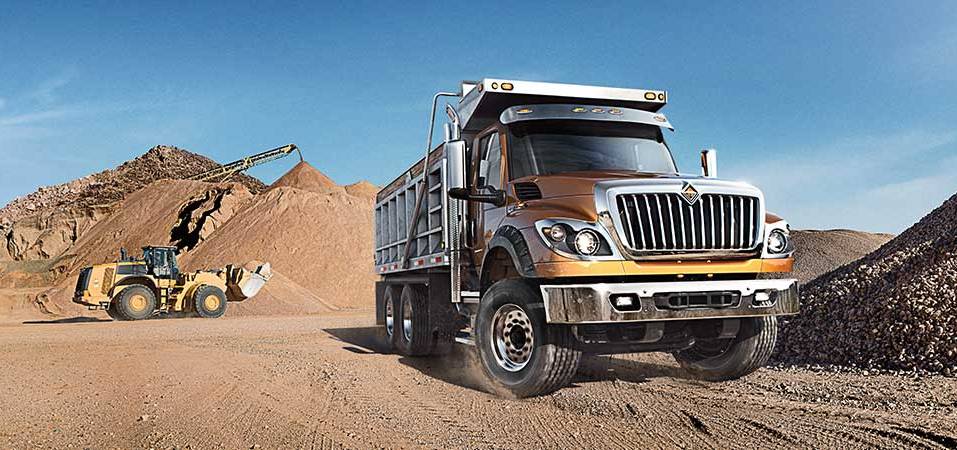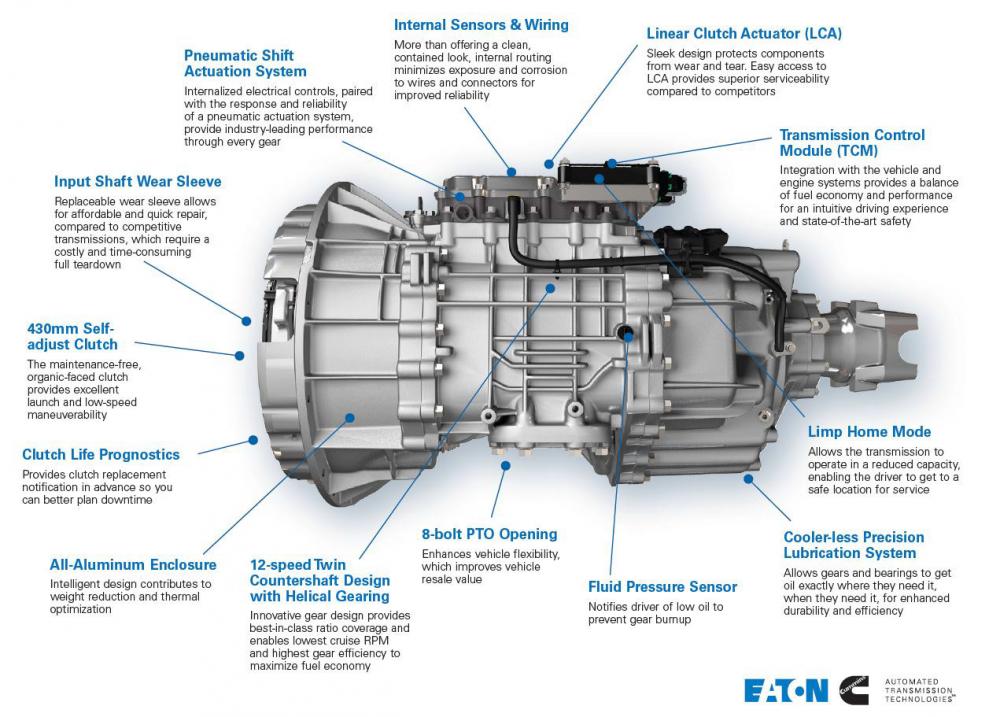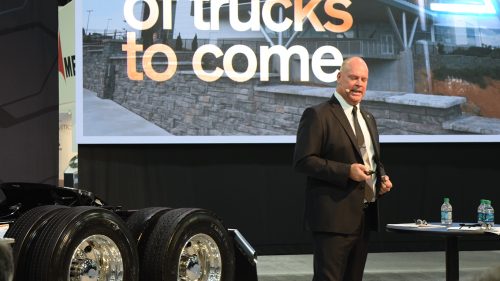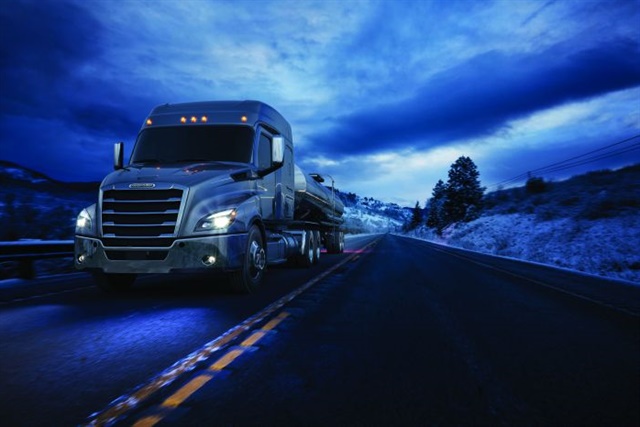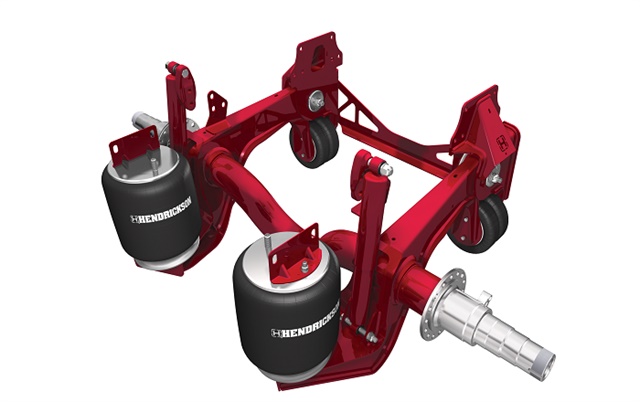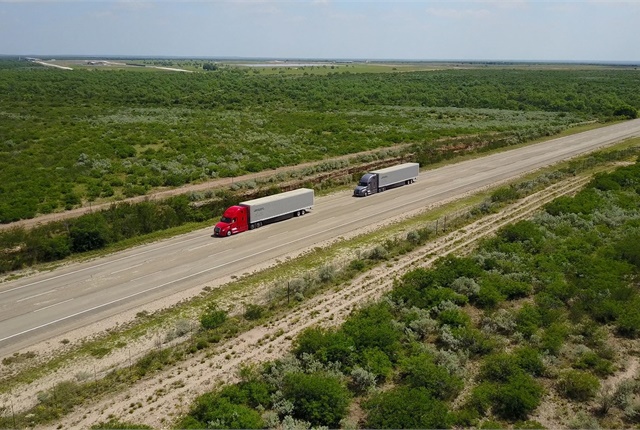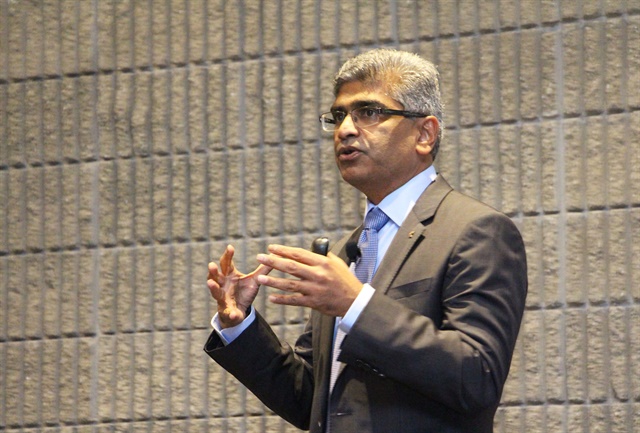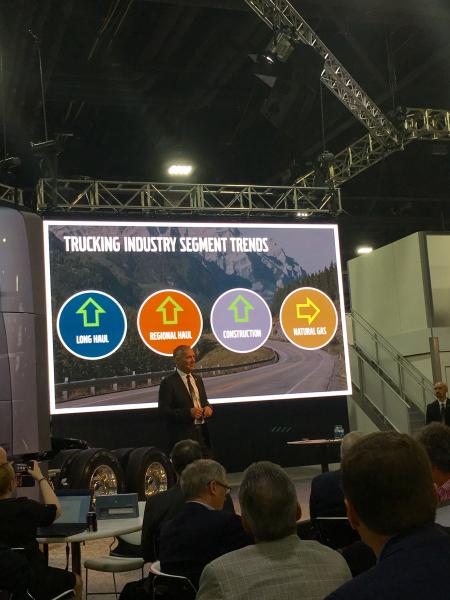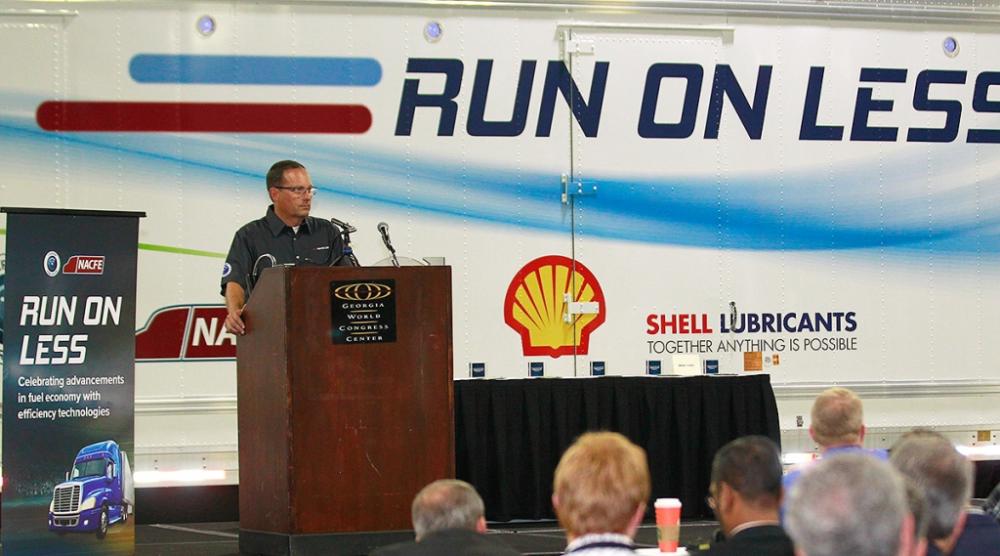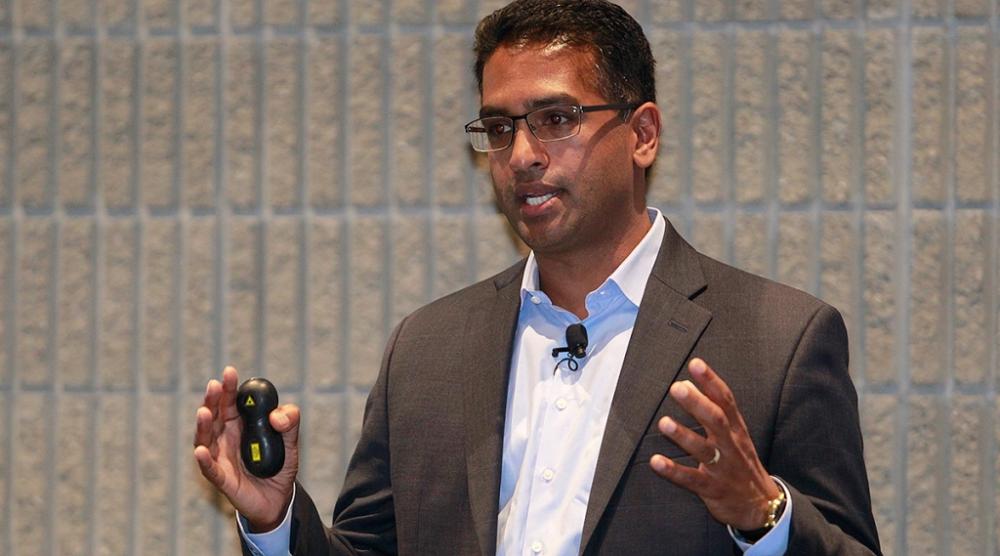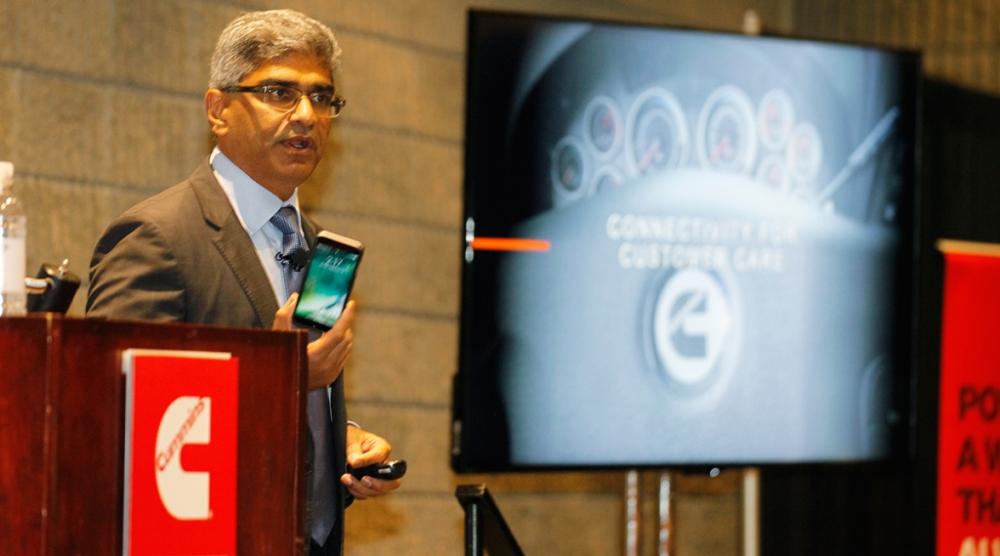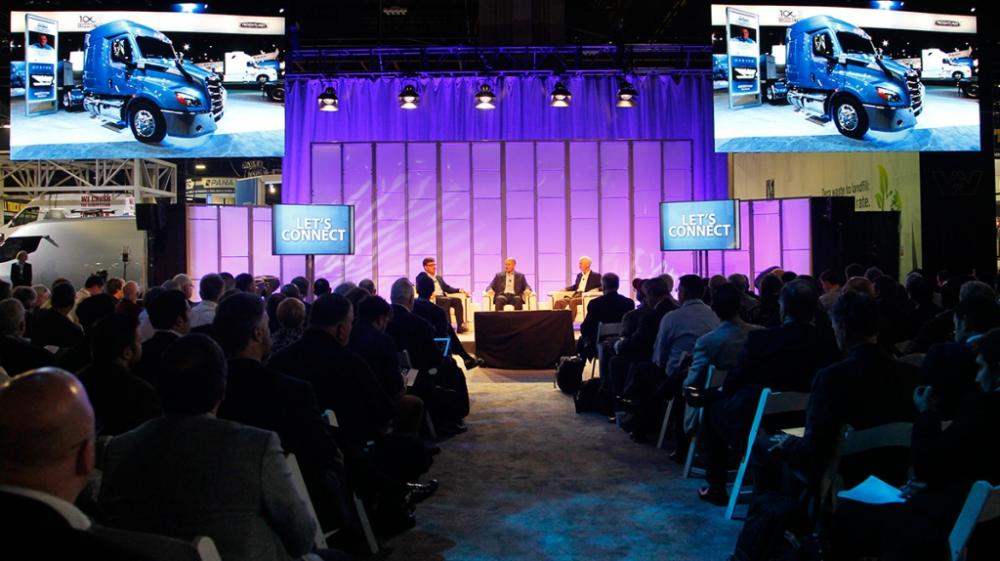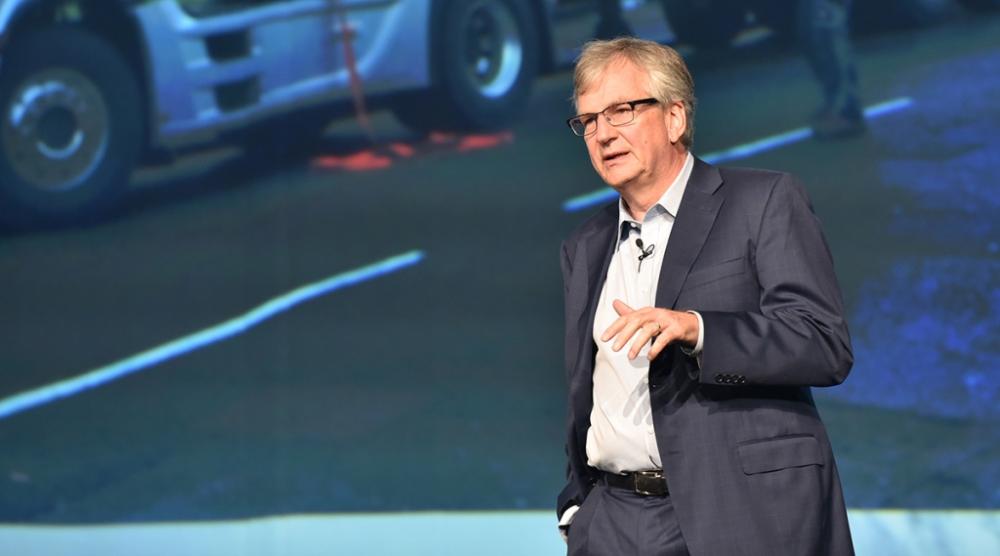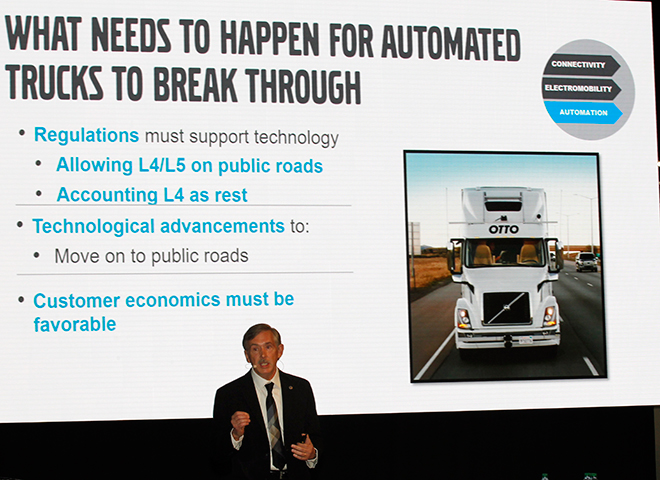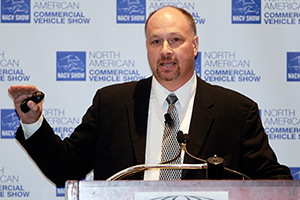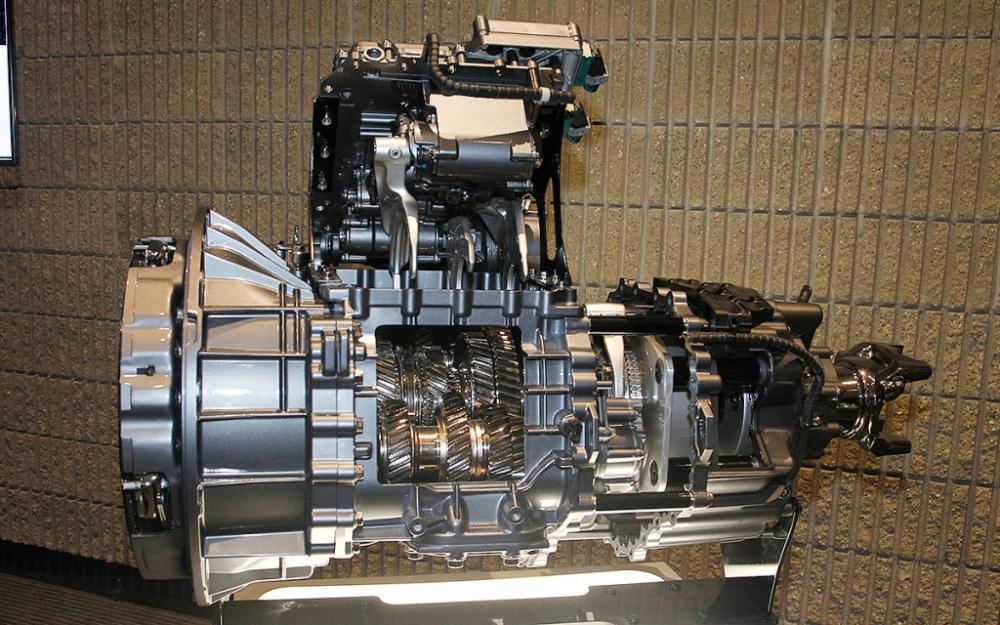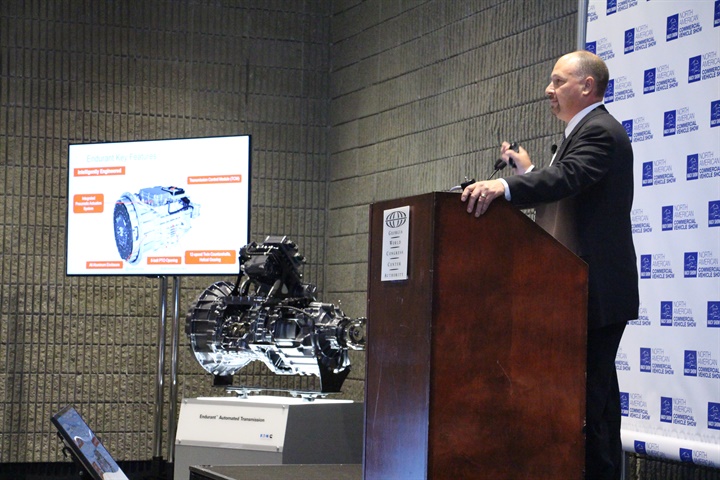
kscarbel2
Moderator-
Posts
18,927 -
Joined
-
Days Won
114
Content Type
Profiles
Forums
Gallery
Events
Blogs
BMT Wiki
Collections
Store
Everything posted by kscarbel2
-
International reveals new vocational truck James Menzies, Truck News / September 25, 2017 ATLANTA, Ga. – International took the wraps off a new HV vocational truck at the North American Commercial Vehicle show here today. The truck will come with the International A-26 engine, and was designed with uptime in mind, according to Denny Mooney, senior vice-president of global product development. It was also designed to be more body-builder friendly, with the Diamond Logic electrical system that allows for multiplexing and easier integration of truck bodies. The hood and grille weren’t updated, but the interior was completely redesigned. “This vehicle was designed from the inside out,” said Mooney. “You have to get inside to appreciate what we’ve done.” Mark Stasell, vice-president of vocational trucks with Navistar, said the door has been redesigned with more stiffness to provide better sealing. This has reduced air leaks and wind noise. More than 100 customers were consulted during the redesign. The window belt line was lowered for improved visibility and the vent window post was also eliminated. Side mirrors were pushed forward, so less head turning is required when checking them – 15% less to the left, and 5% to the right. The premium gauge cluster was borrowed from the LT highway model. There’s a customizable display in the center, where drivers can view items such as fuel economy, virtual air gauges, or axle loads. A new stalk shifter was designed for the steering column, and a center vent was added to provide better cooling in three-man operations. The truck also gets an improved HVAC system, with a max defrost feature that quickly clears the windows. The HV is the latest in a series of new model introductions from International. It also announced new options for its HX series vocational truck. The HX 520 and HX 620 will soon be available with 51-inch short sleeper, for customers who want more interior space or are away overnight on occasion. Those will be available for order in October. And the HX 515 and 615 will be available with the International A-26 engine as of May 2018. Mooney also mentioned a redesigned LoneStar is now available. It has adopted the LT series interior. .
-
New options and features available for Freightliner, Western Star trucks Jason Cannon, Commercial Carrier Journal (CCJ) / September 25, 2017 Freightliner is adding a mid-roof cab configuration for its Cascadia the company announced Monday at the North American Commercial Vehicle Show in Atlanta, including 48-, 60- and 72-inch mid-roof XT sleeper cabs in both 116- and 126-inch BBC platforms. All three configurations offer a choice of Aero or AeroX aerodynamic packages. Customers can place orders now for delivery in January. Senior Vice President of Sales & Marketing for Daimler Trucks North America (DTNA) Richard Howard notes to-date, the company has received 25,000 orders for the new Cascadia. “It took us 3 years [to reach 25,000 orders] when we launched the classic Cascadia,” he adds. Allan Haggai, DTNA marketing communications manager, says new features on the 116- and 126-inch platforms include a service-friendly electronic vault (eVault) that offers convenience and weather protection that increase uptime. “It’s housing all the electrical modules and making them easier to access,” says Howard. An all LED-lit interior and exterior lights is also available, as is an ergonomic dashboard and display screen. Detroit Connect and Detroit Assurance 4.0 have been integrated and the new truck design improves fuel economy compared to previous models. A Driver Loft option is available in the 72-inch mid-roof XT configuration with a two-seat dinette/work table and opposing seating. The seats fold flat to allow a full Murphy-style bed to swing down. Freightliner Trucks has also partnered with Hendrickson to offer the OPTIMAAX 6×2 liftable forward tandem axle on the Cascadia. Offering a weight reduction of up to 400 pounds versus a comparable 6×4, the OPTIMAAX features automated controls that sense load capacity, either lifting or lowering the axle as-needed without driver input. A raised axle enhances traction and helps fleets that focus on weight reduction and want to optimize fuel efficiency. The OPTIMAAX 6×2 axle design is compatible with drum and air disc brakes, and the axle is fully welded, not bolted, offering additional strength and durability. Detroit Connect Remote Updates will be available to Cascadia owners with Detroit engines next month. Kary Schaefer, DTNA general manager of marketing and strategy, says the over-the-air functionality, which includes parameter programming capability, gives fleets the flexibility to build their own profiles using the Detroit Connect portal, which they can use to update one truck, a set of trucks or their entire fleet. Utilizing the Detroit Connect platform’s cellular connection, fleet managers can change maximum road speed, maximum cruise speed, idle shutdown time, and idle shutdown minimum/maximum ambient air temperature parameters. Remote Updates is included with the base Detroit Connect package, which is available standard for five years with the new Cascadia, and will be retroactively available on all Detroit-powered new Cascadias. Freightliner’s severe duty lineup is also getting updated with six new product options: the Allison 4700 Rugged Duty Series (RDS) automatic transmission for the 114SD and 122SD; LifeGuard RollTek seats; improved routing and clipping; LED headlights for the M2 106 and M2 112; Bendix Tire Pressure Monitoring; and a low-profile 122SD auto hauler package that lowers the laden roof height to approximately 100-inches. Also Monday, DTNA announced new options for its Western Star trucks. Available for 4700, 4800, 4900 and 5700XE models, Michelin’s X Multi D tire is a factory-installed option targeting regional applications like dry van LTL, food and beverage, pick up and delivery, tankers, energy and construction. Western Star 4700 Models can now be spec’d with factory-direct H4 halogen headlight bulbs, which provide a brighter light than regular incandescent bulbs for better visibility. Alternatively, 4800 and 4900 Models can get LED headlights factory-installed. Western Star has also expanded the capacity of its in-cab battery box to hold up to four batteries. Available for 5700XE day cabs, the batteries are under the passenger seat instead of the side of the chassis. This option can help extend the life of the batteries by protecting them from extreme weather conditions, road spray and harsh chassis vibrations. The new options also allows customers to spec a tractor with a shorter wheelbase. .
-
Jason Cannon, Commercial Carrier Journal (CCJ) / September 25, 2017 Over past two years, International has introduced a new or refreshed product every 4 to 6 months, giving the Lisle, Ill.-based truck-maker the distinction of featuring the industry’s newest truck lineup. Monday, at the North American Commercial Vehicle Show in Atlanta, Navistar continued its tractor reinvention with the debut the driver-centric HV Series severe service truck. “Imagine [an interior] space that works for drivers operating these kinds of trucks,” Denny Mooney, Navistar senior vice president of product development, says of the truck’s driver-centric design. “All the design features in this cab were driven by feedback from more than a 100 [vocational customers],” adds Mark Stasel, Navistar vice president of vocational trucks. The truck, Mooney says, was designed “from the inside out” for increased driver comfort, but in the “inside out” design, the inside got more attention than the outside of the reworked WorkStar. “One of the things we didn’t change was the hood and the grille,” he adds. As with International’s RH and LT trucks, newly redesigned doors remove the vent window and improve seals, minimizing air leaks and wind noise. Pedestal mirrors have been moved forward, improving visibility and allowing drivers to turn their head to a lesser degree. A new premium instrument cluster sits center of the driver, complete with driver information display, and is the same unit that featured in the LT, RH and LoneStar. The transmission selector has been moved to a stalk on the steering column and integrated with the engine brake. The wing panel has been redesigned to increase knee room and an AC vent has been added in the center panel for riders. The fuse panel has been integrated in the top of the dash, another nod to the LT and RH. The HV Series also features International’s Diamond Logic electrical system for the automation of tasks and interlocks to help protect both equipment and crew, and the truck was designed to ease the process of body upfitting. “Our Diamond Logic electrical system is best known for its ability to provide control and communication between work trucks and body equipment,” Stasel says. The Diamond Logic electrical system offers nearly 200 factory available body integration and driver efficiency features, plus the ability to customize more vehicle functions. Cross member anchored tow loops prevent frame twisting. The Super Single half-inch thick fame rail is rated up to 3.35M RBM and an integral – not bolt on – 20- and 27-inch frame extension adds rigidity. A 20,000 lb. off-set bowl front drive axle allows for a lower ride height than a traditional center bowl. Configurations range from 4×2 to 8×6 and BBCs of either 107- or 113-inch and set-forward or set-back front axles are available. A clean Cab-to-Axle (CA) configuration is also available. The HV comes standard with International’s in-house engineered A26 engine with Cummins B6.7 and L9 engines available as options. With an inside wheel cut of up to 50 degrees, the HV Series can navigate tight city streets. The HV Series – available for order today – is available in a variety of specifications: Regular Cab, Extended Cab, and Crew Cab. Also on the vocational front, Navistar says its models HX 520 and HX 620 will get a 51-inch short sleeper option next month, while the HX 515 and HX 615 will feature the A26 engine in May. Navistar also made public its intentions to upgrade features on its OnCommand Connection platform, including a prognostic platform that can diagnose faults before they occur. “We can tell customers we will proactively identify problems before they ever happen … before anything fails on the truck and the customer experiences downtime,” Persio Lisboa, Navistar Chief Operating Officer, says of the company’s Live Action Plans platform. Automated Driver Vehicle Inspection Reporting, another integrated function of OnCommand Connection, Lisoba says, will relieve drivers of much of the paperwork associated with the vehicle inspection process, but ensures a fleet’s inspection protocols are followed. .
-
Eaton Cummins releases Endurant AMT for linehaul trucks
kscarbel2 replied to kscarbel2's topic in Trucking News
Eaton Cummins debuts new 12-speed automatic Jason Cannon, Commercial Carrier Journal (CCJ) / September 24, 2017 Eaton Cummins Automated Transmission Technologies on Sunday at the North American Commercial Vehicle Show in Atlanta debuted its new Endurant 12-speed automated transmission. With ratings up to 1,850 lb.-ft. of torque, Endurant –the first product to launch under the Eaton-Cummins joint powertrain venture – will be matched with the Cummins X15 Efficiency Series engines rated up to 510 hp beginning next month for Peterbilt 579 and Kenworth T680. Peterbilt and Kenworth also offer a variant of the Endurant for their MX engine line. “This is a purpose built automated transmission,” says Scott Davis, general manager, Eaton Cummins Automated Transmission Technologies, “designed and built for the North American commercial vehicle space. It is the lightest, the most efficient product on the market.” Endurant, the lightest heavy duty automatic on the market by 105 pounds, features an internal electrical system routing that minimizes exposure and corrosion to wires and connectors for improved reliability. “There’s really very little hanging on the outside of the transmission,” says Gerard DeVito, vice president, Technology, Eaton Vehicle Group. “You can change the clutch actuator without taking the transmission out of the vehicle. That saves you about $5,000 on your repair bill.” A new prognostics feature provides clutch replacement notification to better plan maintenance scheduling. An industry-exclusive transmission fluid pressure sensor notifies drivers of low oil levels to provide burn-up warranty coverage. Smooth and intuitive shift strategies that enhance the operator’s driving experience. Predictive shifting using look-ahead technology to execute shift decisions that improve fuel efficiency and provide additional driver comfort and a standard, eight-bolt PTO opening for resale value improvement. Endurant also employs a pneumatic clutch actuator. “As long as you keep it clean, you get a lot of force at very little cost,” DeVito says. Eaton Cummins relied on more than 400 hours of collaborative efforts from customer councils, driver councils and services councils to aid the package’s design. The groups helped identify the most important features. DeVito says Endurant offers the lowest cruise RPM among competitive automated transmissions and deeper overall ratios to support downspeeding to help save fuel. “Among line haul transmissions, Endurant has the deepest reverse ratio in the industry for slow speed maneuvering,” he says. Field tested over more than 2 million equivalent miles, Endurant features a 750,000-mile lube change intervals for linehaul applications – the industry’s longest and 250,000 to 450,000 miles longer than competitive models.” “Nobody wants to change oil. Oil is a challenge to get rid of,” DeVito says. A maintenance-free 430mm self-adjust clutch that requires no grease and Endurant requires only 16 pints of oil, about half the amount of competitive models. A replaceable input shaft sleeve allows for affordable and quick repair, while competitive transmissions require a costly and time-consuming full teardown. Endurant is available with IntelliConnect, a telematics capable system that enables near real-time monitoring of vehicle fault codes, critical event prioritization and provides a comprehensive action plans by technical experts at Eaton. The standard Endurant transmission warranty is 5-year/750,000 miles for line haul commercial vehicles, and 3-year/350,000 miles for the clutch. One-year and two-year extended protection plans are also available. Endurant’s maximum operating weight (GCVW) is 110,000 lbs.; maximum horsepower is 510 HP, and oil capacity is 16 pints. . -
Matt Cole, Overdrive / September 25, 2017 A potential problem with certain Dana steer axles that could cause the tie rod to loosen has prompted a recall of more than 1,000 trucks manufactured by Volvo, Mack and Autocar. According to National Highway Traffic Safety Administration documents, the castellated nut on the steer axles may not be properly torqued, allowing the tie rod to loosen. If the tie rod loosens, it can disconnect from the steering knuckle, causing a complete loss of steering in the trucks. The recall affects trucks equipped with certain Dana D-Series and E-Series steer axles. NHTSA documents state that drivers of affected trucks would notice an audible noise and looseness in steering before the tie rod fully disconnects. Mack Trucks is recalling approximately 477 model year 2016 Pinnacle CHU and CXU trucks manufactured between March 9, 2015, and June 26, 2015. Mack will begin notifying owners on Oct. 16. Mack dealers will inspect the torque of the castellated nut and tie rod, tightening if necessary. If the tie rod stud and knuckle can’t be torqued correctly, Mack will replace the knuckle and tie rod end for free. Owners can contact Mack customer service at 800-866-1177 with recall number SC0408. NHTSA’s recall number is 17V-535. Volvo Trucks is recalling approximately 497 model year VNL and VNM trucks manufactured between March 20, 2015, and June 30, 2015. Volvo will begin notifying owners on Oct. 16 and will follow the same procedure as Mack to fix the issue. Owners can contact Volvo customer service at 800-528-6586 with recall number RVXX1702. NHTSA’s recall number is 17V-536. Two separate recalls from Autocar affect approximately 85 model year 2017 Xpeditor severe duty trucks, and approximately 30 model year 2016 Xpert medium- and heavy-duty trucks and Xspotter terminal tractors. The Xpeditor recall affects trucks manufactured between March 2, 2015, and Aug. 24, 2015. Autocar began notifying owners on Sept. 20, and will inspect the torque of the affected parts and tighten as necessary. Owners can contact Autocar customer service at 888-218-3611 with recall number ACX-1703. NHTSA’s recall number is 17V-533. The Xpert and Xspotter recall affects Xpert trucks manufactured between March 23, 2015, and July 22, 2015, and Xspotter trucks manufactured between April 27, 2015, and May 26, 2015. As with the Xpeditor trucks, Autocar began notifying owners on Sept. 20. Owners can contact Autocar customer service at 877-777-5360 with recall number MDTT-1701. NHTSA’s recall number is 17V-534.
-
Volvo Sees Growth in 2018, Especially With VNR
kscarbel2 replied to kscarbel2's topic in Trucking News
Volvo eyes trucking’s future with 2017 product updates James Jaillet, Commercial Carrier Journal (CCJ) / September 25, 2017 In a year that’s seen the company roll out two updated tractors and a futuristic concept tractor-trailer, Volvo Trucks North America said Monday it’s readying itself for the future of freight transportation. In a press update held at the North American Commercial Vehicle Show, Volvo recapped its busy year of updates, offering a bird’s eye perspective of what the new technology means for the trucking industry and its future. The company unveiled this year a refreshed VNL tractor for the long-haul market and a new tractor, the VNR, targeting the regional-haul segment. In March, the company debuted its SuperTruck tractor-trailer, a $40 million venture built via a partnership with the U.S. Department of Energy. The Volvo SuperTruck achieved a 12 mpg average, and Volvo brought features developed as part of the SuperTruck’s research and development to its current product line. Its 2017 D13 engine brings 7.5 percent better fuel efficiency than its 2014 predecessor, said Volvo’s Magnus Koeck, VP of Marketing. The engine leans on features like turbo compounding, a form of waste heat recovery, and wave pistons to achieve its fuel economy gains. The long-haul tractor powered by the D13, Volvo’s new VNL, also “takes another step” in fuel efficiency, says Koeck. “This isn’t a 6 mpg truck anymore,” Koeck says of the sculpted aerodynamic unit. The VNL also features new exterior stylings, like an updated grille, and a refreshed and driver-focused interior. The company will be showing off the new VNL in a truck stop tour taking place between Oct. 3 and Oct. 14 in select truck stops across North America. Take rates on the company’s powertrain package, which combines the D13 and the I-Shift automated-manual transmission, are close to 95 percent, says Koeck. Take rates on the I-Shift alone are upwards of 90 percent. “Those are strong numbers,” he said. “They’re hard to beat.” Volvo also said it’s pressing to connect more Volvo trucks to its Remote Programming platform, which allows over-the-air software updates and engine repogramming. The system aims to cut downtime and make it easier for Volvo trucks and engines to maintain up-to-date software. Currently, about 135,000 trucks are connected to the system, says Volvo. The company made its remote diagnostics system standard in 2012. It launched the remote programming element earlier this year. Eyeing the future of transportation, Volvo’s Keith Brandis said the company is investing in three key technology areas — connectivity, electrification and automation — as well as the convergence of the three, which will create a “dramatical future,” says Brandis. Such technologies are still in a fledgling state, says Brandis, and much work needs to be done in the public and private sector before these systems come to market. But technologies like electrification, automation and connectivity can solve some of transportation’s most pressing issues, such as congestion and gridlock, as well as safety. “The future is coming and it’s coming fast,” says Volvo Trucks’ President Goran Nyberg. “We’re excited to find new ways to improve efficiency, safety and, above all, the productivity of the industry.” . -
Freightliner Offers New Cab Configurations for Cascadia
kscarbel2 replied to kscarbel2's topic in Trucking News
Cascadia gets mid-roof cab Today’s Trucking / September 25, 2017 ATLANTA, GA – Freightliner has expanded the lineup for its New Cascadia, with a mid-roof cab that targets overnight regional haulers as well as bulk haulers and flatbed operations. Cascadia configurations now include 48-, 60- and 72-inch mid-roof XT sleeper cabs in 116- and 126-inch BBC platforms. All three offer Aero or AeroX aerodynamic packages as well. Order books for the new mid-roof models are now open, for delivery in January 2018. But there have already been plenty of orders for the New Cascadia as a whole. The company has officially reached a milestone of 25,000 units, even though the truck was only unveiled last September. It took three years to reach that number when the classic Cascadia was launched, says Richard Howard, senior vice president – sales and marketing at Daimler Trucks North America. The promise of a potential 8% boost in fuel economy is also being fulfilled, and “some are even getting more,” he added. About 95% of Cascadias are also being ordered with a DT12 Automated Manual Transmission. -
Today’s Trucking / September 25, 2017 ATLANTA, GA – Daimler Trucks North America unveiled an array of truck options, apps and upgrades during the inaugural North American Commercial Vehicle Show (NACV) in Atlanta, Georgia. Service apps Completing a work order or tracking repairs? Daimler Trucks North America has some apps for that in the form of the new Express WriteUp and updates to Uptime Pro. The Express WriteUp app gives service advisors a tool to wirelessly complete repair orders. Once a truck arrives, vehicle data is collected by scanning the VIN or QR code found on the door pillar. That taps into warranty coverage, repair history, and Virtual Technician details. “A scanned vehicle number eliminates human entry errors and further speeds the overall repair process,” said Marty Kubiak, manager - central service systems, Daimler Trucks North America. “An incorrect VIN can create many problems downstream of the repair process. The intake process for a truck repair is the first and most critical step.” Once the vehicle is received, Uptime Pro connects dealers and customers throughout the repair process, connecting to the dealer management system, and enabling email and text messages. Email responses from customers are also automatically logged to the repair order. Western Star options Michelin X Multi D tires are now available for Western Star 4700, 4800, 4900 and 5700XE trucks as a factory-installed option. They’re best suited for dry van LTL, food and beverage, pickup and delivery, tankers, energy, and construction applications, the company says. New options for Western Stars don’t end there, though. Western Star 4700 models can now be spec’d with factory-direct H4 halogen headlight bulbs, said to offer a brighter light than regular incandescent bulbs. And the 4800 and 4900 models include factory-installed LED headlights. In-cab battery boxes for the 5700XE day cabs, meanwhile, have also expanded to hold up to four batteries under the passenger seat, rather than requiring them to be mounted on the chassis. That can help to protect batteries from weather conditions and road spray, as well as limiting chassis-related vibrations. Hendrickson forward tandem Freightliner and Hendrickson are partnering together to offer the Hendrickson Optimaax 6x2 liftable forward tandem axle exclusively on the New Cascadia. The liftable axle comes into play when carriers like bulk haulers or delivery vehicles have diminishing loads. The load capacity is sensed automatically, lifting or lowering the axle as required. Benefits are not limited to better fuel economy. There’s improved traction when backing under trailers in soft soil or other low-traction conditions. And maneuverability is improved when the axle is raised. The design is compatible with drum and air disc brakes, while the axle itself is fully welded rather than bolted on. It’s about 300 to 400 pounds lighter when compared to a 6x4, the companies add. It’s available in the second quarter of 2018. Severe-duty enhancements Freightliner has unveiled six new product options for its severe-duty trucks. Now available on the Freightliner 114SD, the Allison 4700 RDS provides heavy vocational operators with improved startability, two reverse gears, enhanced PTO options and the durability required for severe applications. It’s also available with the Freightliner 122SD. Optional LifeGuard RollTek seats can offer added protection in the event of a rollover. They have side-impact airbags that deploy as the seatbelt tightens and the seats compress to the lowest possible position. Routing and clipping have improved throughout Freightliner’s vocational truck lineup as well, thanks in part to new standoff brackets and simplified body and equipment mounting. And the Bendix Tire Pressure Monitoring System is also an available option. On Freightliner M2 106 and 112 trucks, modular LED headlights have been introduced. And for auto haulers, the new 122SD Auto Hauler Package is offered in a collaboration with Fontaine Modification. It lowers the laden roof height to 100 inches, supporting those who require a sleeper berth.
-
Heavy Duty Trucking (HDT) / September 25, 2017 The Freightliner Cascadia is now available in mid-roof cab configurations for regional overnight haulers and segments such as bulk haul and flatbeds, the company announced at the North American Commercial Vehicle Show in Atlanta. The configurations include 48-, 60- and 72-inch mid-roof XT sleeper cabs in both 116- and 126-inch BBC platforms. All three configurations offer two levels of aerodynamic packages, the Aero or AeroX, Freightliner’s most fuel-efficient specification. The new configurations are available to order now, for delivery in Jan. 2018. “The addition of the mid-roof configuration allows more customers in different applications to experience the benefits of the new Cascadia,” said Mike McHorse, manager, on-highway product marketing, Freightliner Trucks. “Since the new Cascadia debuted in September 2016, it has earned praise as the most productive, efficient and driver-friendly truck Freightliner has ever offered to the industry.” Features of the new Cascadia include: A service-friendly electronic vault (eVault) that offers convenience and protection from the elements while also increasing uptime. The eVault’s central location allows for easy access when troubleshooting most electronic control units. All LED-lit interior and exterior lights, making the lighting system more maintenance-friendly than ever. An ergonomic dashboard and display screen designed for the driver. Its layout helps drivers access gauges and switches without reaching and includes an easy-to-read instrument cluster display. Detroit Connect and Detroit Assurance 4.0 seamlessly integrated into the new Cascadia to offer enhanced fleet management, increased uptime and improved safety. Improved fuel economy compared to previous models, an upgrade stemming largely from rigorous tests in DTNA’s proprietary full-scale wind tunnel and millions of miles of real world testing. A Driver Loft option is available in the 72-inch mid-roof XT configuration featuring a two-seat dinette/work table and opposing seating. These seats can be folded flat to allow a full Murphy-style bed to swing down in less than 15 seconds. To customize the Cascadia in its 10 different day cab and sleeper options, visit www.Freightliner.com/configurator. .
-
Hendrickson 6x2 Liftable Forward Tandem Axle Available on Cascadia
kscarbel2 replied to kscarbel2's topic in Trucking News
OPTIMAAX for Freightliner New Cascadia Hendrickson / September 25, 2017 OPTIMAAX is Hendrickson's 6x2 Liftable Forward Tandem Axle and Suspension System - OPTIMIZE fuel economy and weight savings on Freightliner’s New Cascadia. . -
Heavy Duty Trucking (HDT) / September 25, 2017 ATLANTA — Hendrickson Truck Commercial Vehicle Systems has partnered with Freightliner Trucks to offer the OptiMaax 6x2 liftable forward tandem axle on the new Cascadia, the company announced at the North American Commercial Vehicle Show taking place this week in Atlanta. The OptiMaax axle can help fleet customers optimize the movement of variable loads, as well as assisting carriers with diminishing loads, such as bulk haulers and delivery vehicles that may have empty back hauls after carrying items such as groceries, livestock, beverages, and fuel. It also helps fleets that focus on weight reduction and those who want to improve fuel efficiency. Automated controls sense the load capacity and either lift or lower the axle without relying on the driver, maximizing time with a raised axle and enhancing traction. The OptiMaax 6x2 design is compatible with drum and air disc brakes and is unique because the axle is fully welded, not bolted, adding strength and durability according to Hendrickson. The benefits: Boosting fuel efficiency Reducing weight by 300 to 400 pounds over a comparable 6x4, allowing trucks to either carry additional weight or save fuel Gaining traction when backing under trailers in soft soil or low traction conditions Improving maneuverability when the lift axle is raised Saving money on tolls where lift axles are not charged if lifted “This combines a leader in heavy trucks with a leader in suspension technology,” said Gerry Remus general manager sales and business development for Hendrickson Truck Commercial Vehicle Systems. “It’s one more way we’re focused on engineering our product for efficiency, and are lowering the overall running costs for fleets.” .
-
Heavy Duty Trucking (HDT) / September 25, 2017 ATLANTA — For the first time in North America, Daimler Trucks showcased its entire lineup of commercial vehicles, from mid-sized vans to school buses to Class 8 long-haul tractors at a press event kicking off the opening day of the North American Commercial Vehicle Show (NACV) in Atlanta today. The collection of vehicles, highlighted with a concept model of a next-generation Sprinter van, was a clear indication that Daimler views the future of logistics as coordinated, data-driven chain dependent on the efficient deployment of all sorts of vehicles with different sizes, shapes, and capabilities. During the press briefing, Roger Nielsen, president and chief executive officer of Daimler’s North American Truck business division also noted that the company has been testing advanced platooning systems on public roads in both Oregon (near Portland, where the company’s North American headquarters is located) and in Nevada, which was an early adopter of autonomous vehicle regulations in 2014. The tests are based largely on the Detroit Assurance suite of active vehicle safety systems, Nielsen said, which enable coordinated vehicle movement at close following distances in platooning applications to take advantage of increased fuel efficiency brought enabled by shared aerodynamic efficiencies. Nielsen noted that Daimler engineers have been testing platooning systems on test tracks and select U.S. highways, demonstrating how the new technology can improve fuel efficiency, driver productivity, convenience, and safety. The first step of platooning is called “pairing,” where two trucks travel in tandem at distances closer than what is possible under manual operation. A team of engineers is testing the system in trucks under controlled circumstances in both Oregon and Nevada highways, driving in cooperation with officials in those states. In addition to road testing, Nielsen revealed that DTNA is conducting coordinated braking tests on a closed track at the company’s High Desert Proving Grounds in Madras, Ore. in preparation for a fleet trial early next year. “Platooning holds the potential to offer significant fuel economy advantages, while assisting drivers,” said Roger Nielsen, president and CEO, DTNA, who has driven the new Cascadia under platooning conditions using this technology. “To be sure, the platooning technology is not meant to replace drivers – it’s designed to help drivers.” “If we can help relieve drivers while they are on highways, they will likely become less fatigued,” continued Nielsen. “That can reduce the risk of crashes and make the driving experience more comfortable. Commercial development of platooning will depend on several factors, including government regulations,” Nielsen said. “The bottom line: we see a growing number of customers interested in platooning. When America is ready for platooning, we will have a proven solution.” .
-
Tenneco Pursues Waste Heat Recovery for Trucks
kscarbel2 replied to kscarbel2's topic in Trucking News
Tenneco Highlights Waste-Heat Recovery, Ride-Improvement Solutions Heavy Duty Trucking (HDT) / September 24, 2017 ATLANTA. Tenneco Inc. showed off its latest array of emssions-related and ride-performance products at a press conference held here on Sept. 24, ahead of the North American Commercial Vehicle Show. “Tenneco is pleased to showcase its global expertise in complete design, engineering and systems integration for the commercial vehicle market,” said Ben Patel, vice president and chief technology officer, He explained that the company’s global range of commercial-vehicle “clean air solutions reduce emissions, contribute to improved fuel economy, and enhance vehicle performance” while its ride-related products range from coil and air spring dampers for cabs, rear axles and seat dampers to lightweight torque rods and elastomer suspension bushings. According to Patel, the concept box is part of Tenneco’s focus on developing waste-heat recovery systems for commercial vehicles. He explained that waste-heat recovery helps speed up chemical reactions and that allows captured and stored heat from a vehicle to be leveraged to enhance engine operating efficiency. At NACV, Tenneco is also showcasing the newest member of its XNOx Liquid Urea Selective Catalytic Reduction product family-- an integrated dosing-control unit concept that integrates the pump, motor, injector, controller, sensors, water cooling, and control software in a single device. Patel said that the company’s current production XNOx urea-dosing system, first introduced in 2011, now offers “expanded thermal range,” which means the system can be placed closer to the turbocharger without compromising dosing quality and performance. “The return flow design provides superior thermal tolerance without added complexity.” He said other enhancements include an optional controller that features a flexible engine interface design and can predict engine-out NOx and account for ammonia storage and catalyst degradation. Moving onto thermal management solutions, Patel said that as efficiency improvements and new low-NOx standards continue to drive the need for ultra-high efficiency SCR, Tenneco’s cold start thermal unit offers “an optimal solution that provides active heat management for rapid catalyst light-off and efficient NOx conversion through the full range of operating conditions.” He added that Tenneco is also showing off its latest family of mixing solutions designed to efficiently process injected DEF into gaseous ammonia without the formation of undesired deposits, even at low engine loads, which helps meet NOx efficiency requirements for low or non-EGR calibrations as well as emission targets under “real field” operations. As for the ride-improvement side of its business, Patel noted that the company’s 45mm axle dampers, used primarily as rear axle dampers for vehicles with GGVWs above 15 tons and on trailers, boast a new valve system that provides “increased tune-ability and allows higher compression damping force while maintaining the lifetime performance typical of Tenneco dampers.” He also pointed out that new designs of Tenneco’s Clevite Elastomers spring eye bushings, which “serve as key pivots in vehicles with leaf-spring suspensions, that reduce mass while improving bushing function and fatigue life are currently undergoing validation. These designs pair a high radial and conical spring rate with low torsional breakaway to produce pivots ideally “ideally suited for optimal suspension performance.” . -
Cummins seeks to capitalize on future trucking trends
kscarbel2 replied to kscarbel2's topic in Trucking News
Cummins Sees a Future with Many Truck Power Options Heavy Duty Trucking (HDT) / September 24, 2017 ATLANTA – Cummins continues to embrace a “buffet” of power sources for the marketplace as it prepares for a future that includes diesel, hybrids, electric powertrains, and fuel cells. “We win in the marketplace by seeing the future first, and beating the competition to it,” proclaimed Srikanth Padmanabhab, president of the Cummins engine business, during a briefing at the inaugural North American Commercial Vehicle Show. “We will be there to provide that power of choice to our customers.” Cummins itself will produce 1.3 million engines this year, bringing its worldwide total to 15 million engines overall. But the underlying source of power is clearly evolving. Future internal combustion engines could be fueled by diesel, natural gas, or gasoline, he said. Battery-electric systems will find a place depending on specific applications, particularly in regional and urban environments -– especially as batteries improve. Cummins expects range-extended electric vehicles in 2019 and 2020 to serve the bus market and urban pickup and deliveries, and it has also unveiled an electric Class 7 urban hauler. “We’ve been in this electrified business for well over two decades,” he stressed. “The technology is viable, and it’s economically viable in certain markets.” In selected cases, hybrids will combine electric and internal combustion power. And there will be a place for fuel cells, too. Emissions-friendly technologies are rolling out in markets around the world, improving the quality of life in the urban environments from Amsterdam to New Delhi and Beijing, he added. It isn’t the only way the engines are evolving. Fifteen years ago, industry disruptors came in the form of globalization, emissions, and available power. Today, he said, the driving issues are diversity, connectivity, and automation. As important as the fuel will be, connectivity is reshaping powertrains through the confluence of sensors, analytics, and artificial intelligence. To demonstrate that, he discussed how smartphones have become commonplace because of the combination of reliable hardware and killer apps. In the latter case, he referred to the way that Waze has become popular. Each phone has a GPS locator and accelerometer, and Waze has connected that to a network of people who can provide traffic data. That has disrupted the marketplace despite the navigation systems available through OEMs. Engines were incorporating electronics as early as the 1980s, but communication-related technologies have reached a critical tipping point. “We did not have WiFi until recently. We didn’t have Bluetooth capability until recently,” he said. “We were not able to analyze data in a meaningful way.” “I’m so excited about this connected enterprise we’re talking about,” Padmanabhab said, referring to the ability to collect masses of data that might otherwise be glossed over. Cummins Connected Customer Care, for example, is linking diagnostic capabilities, software and service providers. “We’ll be doing predictive shifting. We’ll be doing optimized power depending on where you are in the U.S.,” he observed. “This will lead to intelligent braking and this will lead to other things.” The next generation of Cummins powertrains will be lighter, smaller, and produce lower CO2 emissions, and will have the capabilities to be a hybrid, he said, adding that accessories will increasingly become electrified. And hybridization will allow more downsizing, making it possible to spec’ engines with smaller displacements. “We are super excited about this because we’ll be in the longhaul market for the longhaul,” he said. Cummins' Atlanta remarks reiterated what they said during an event last month where they unveiled a concept electric Class 7 truck. . -
Volvo Sees Growth in 2018, Especially With VNR
kscarbel2 replied to kscarbel2's topic in Trucking News
Volvo sees connectivity, electricity, automation shaping trucking's future Neil Abt, Fleet Owner / September 25, 2017 ATLANTA. Volvo Trucks said it is having a strong year, with several updates to its truck lineup and the recent opening of a new customer center. However, much of the focus at its Sept. 25 media event at the North American Commercial Vehicle show was not about the present, but what is to come. “The future is coming faster than we all expect,” said Goran Nyberg, president of Volvo Trucks. The growth of connectivity, electro-mobility, and automation will all have a “dramatic influence” on transportation, said Keith Brandis, Volvo’s director of product planning. Brandis said Volvo is obtaining data on 600,000 connected vehicles across its global brands in the ongoing effort to increase the uptime of all its vehicles. By leveraging connectivity, fleets are now able to tailor vehicle parameters to different types of hauls or terrains. “We are just now at the beginning of this very exciting area,” Brandis said. “Being connected is the key enabler.” Nyberg compared the latest developments in truck connectivity with the smart phone, noting that no one would purchase a particular phone if it needed to be brought into a store each time there was a recommended software update. On a separate topic, Brandis said that while “diesel is still a very energy efficient fuel,” there is no question that electric powertrain systems will continue to rapidly develop. Electric trucks will generally be aimed for city deliveries, although there will be more experiments in regional haul. Brandis said. That will be especially attractive in areas of the world where fuel is up to three times more expensive than the United States. While Brandis cautioned a lack of electric infrastructure is one of the challenges that need to be resolved, Nyberg declared “electrification is coming.” Automation is also advancing, as Volvo and other manufacturers develop systems aimed at assisting the truck driver to be safer and more productive. With platooning and autonomous driving, there are “challenges we as engineers admit we have not figured out,” Brandis said. But significant strides in these areas are being made, such as Volvo’s involvement in a recent truck platooning demonstration in Virginia. The Volvo officials called for federal oversight to promote further progress in this area, a step needed to avoid a piecemeal of state regulations. That sentiment was recently shared by other trucking industry officials during a Senate hearing. . -
Run on Less Kicks Off as Participants Aim for 9 mpg
kscarbel2 replied to kscarbel2's topic in Trucking News
NACFE Test Gets 10.1 MPG Despite Harvey, Irma Challenges Transport Topics / September 24, 2017 ATLANTA — After 50,107 miles driven over 99 driver-days, including battles with Hurricanes Harvey and Irma, seven drivers from seven trucking companies gathered for a victory lap to celebrate 10.1 miles per gallon. The North American Council for Freight Efficiency released details of its Run on Less road trial here on Sept. 24 and reported the drivers topped their goal of 9 mpg by posting a final average of 10.1. The test ran Sept. 6-22 with regular trucks from for-hire and private fleets, all spec’d to maximize mileage and seeing how well they could do “with real trucks, real drivers and real freight,” said Mike Roeth, NACFE’s executive director. The press conference was the first event of the North American Commercial Vehicle Show, which held its inaugural version Sept. 25-28 at the Georgia World Congress Center. Data was gathered from each of the seven trucks — three Freightliners, two Internationals and two Volvos — through a GeoTab Go7 telematics device. The Go7 tracked engine revolutions per minute, torque, location, fuel usage and other figures. Roeth said the weather effects of the two hurricanes made driving difficult, but did not nullify the value of the test. “One driver drove into a Harvey headwind and then had Irma pushing him,” he said. All of the trucks in the test were made either this year or in 2016. The drivers involved ran in linehaul applications, and all of the trailers had aerodynamic skirts and fairings. Beyond the grand total for fuel economy, some of the individual readings were noteworthy. The worst average for a one-day drive, for example, was 7.1 mpg. NACFE estimates the average fuel economy for the nation’s trucks at 6.4 mpg. NACFE took the worst single-day performances across the entire test and averaged them out; the result was 8.8 mpg, demonstrating that even the worst days in the tested trucks were on average just below the original goal for the whole test. Yunsu Park, a consulting engineer who worked on the trial, said the 8.8 number was one of the most impressive for him. NACFE estimates that if the Run on Less equipment were standard on all of the nation’s 1.7 million U.S. highway tractors, and those trucks returned 10.1 mpg instead of 6.4 mpg, the industry would annually save 9.7 billion gallons of fuel worth $24.3 billion. lark Reed of Nussbaum Transportation in Hudson, Ill., drove a Freighliner Cascadia with a 15-liter Detroit Diesel engine during the trial. Reed said he likes the big engine because he often hauls heavy general freight loads of 76,000 pounds, gross weight, over the Rocky Mountains. Reed said he drove his regular truck for the test so there was nothing new to break in. Cory Adams, a Nussbaum driver trainer and coach, said the carrier’s fuel-economy average lately has been about 9 mpg, and that obsessing over fuel has become a way of life. “If we stayed at what we were like in 2009, we’d probably have about 50 trucks now instead of the 300 we do have,” Adams said. Beyond the spec’ing of hardware, Reed and Adams said the company works a lot on driver training to help maximize mileage. Joel Morrow, a driver for Ploger Transportation of Norwalk, Ohio, is a big believer in Volvo’s 6x2 powertrain configurations. He said he would like to see a test like Run on Less happen every year. The storms turned Morrow’s usual routine upside down. Normally, he said, he hauls lighter loads of furniture, often to Houston and Florida. That stopped when the storms started. “I was hauling a lot of water, canned soup and rice — very heavy, dense stuff, but it was my normal truck,” said Morrow, who is also Ploger’s vice president of procurement. Morrow hauled the loads in a truck with an 11-liter engine. He was not able to avail himself of the savings from fully lifting the tag axle, but he said the load-biasing function, which adds weight to the single drive axle, helped maintain traction and safety through the deluge. John Vesey, the operations manager of refrigerated carrier Hirschback Motor Lines of East Dubuque, Ill., said his driver, Brad Long, hauled heavy loads of frozen meat as part of his dedicated contract carriage route. Long drove a 2016 International with a 15-liter Cummins engine because, Vesey said, the company wanted to use a truck and engine that was already well-broken-in. . -
Transport Topics / September 24, 2017 ATLANTA — Vehicle supplier Tenneco Inc. wants to help bring waste heat recovery systems to heavy-duty trucking even though it is not an immediate possibility. Organic Rankine cycle technology is not new, said Tenneco Chief Technology Officer Ben Patel, but putting one under the crowded hood of a Class 8 tractor is an elusive engineering challenge. “No one uses it now,” Patel said of a Rankine system. “It’s complicated. People are pulling their hair out over this. So we’re trying to find a way to use this that’s not a terror,” he said. The Lake Forest, Ill.-based corporation works mainly in emissions controls and thermal management but is also a major supplier of shock absorbers. Its presentation came at a Sept. 24 press conference here at the North American Commercial Vehicle Show. Waste heat recovery captures the unused power of diesel combustion to boil a fluid, probably an ethanol-water mix. The hot gas would then power a turbine for propulsion power and the spent gas gets compressed back into a liquid for another round. While better engine efficiency is most helpful in cutting emissions of carbon dioxide, a greenhouse gas, it is also linked to technology for reducing nitrogen oxides. Patel said heat is “the friend” of emission-control systems. Burning hot improves fuel efficiency and reducing CO2. It also helps minimize soot, or particulate matter. But burning hot also generates a lot of NOx. Therefore, Patel said, the ideal emission system for a truck would combine high-efficiency selective catalytic reduction aftertreatment — for cutting NOx — with a fiery hot engine that is both efficient and a low-level producer of particulate matter. One avenue for improvement, he said, would be better dosing of the exhaust with diesel exhaust fluid, or DEF. Such a truck engine has been a goal of the California Air Resources Board. Patel said Tenneco has been working with CARB on trying to develop a system that can meet California’s NOx goal of 0.02 gram per brake horsepower-hour — a 90% reduction from the current standard of 0.2 gram, which has been in place since January 2010. As for a timeline, Patel said most new U.S. heavy-duty engines are 50% efficient as measured by brake thermal efficiency. He said the target of 55% might be achievable around 2022-2025, and that waste heat recovery with Rankine cycle technology could play a role. “When there is a market for this, Tenneco will be ready,” he said. .
-
Cummins seeks to capitalize on future trucking trends
kscarbel2 replied to kscarbel2's topic in Trucking News
Cummins Outlines Products, Research to Address Changes Disrupting Trucking Transport Topics / September 24, 2017 ATLANTA — Independent engine maker Cummins Inc. said it was prepared to respond with the right products at the right time to the three key disruptive forces reshaping the trucking industry: energy diversity, connectivity and automation. The company outlined its stance to reporters at the inaugural North American Commercial Vehicle Show here Sept. 24. “We want our customers and all users of our products to clearly understand that Cummins brings diversified, dependable technology solutions to our customers at the right time to power their success — always,” said Cummins Engine Business President Srikanth Padmanabhan. “Cummins is prepared to help them be successful now and in the future by offering them powertrain choices that maximize efficiency and reduce costs.” On display at the show were its “super-efficient” X12 and X15 diesel engines, the new Eaton Cummins Automated Transmission Technologies Endurant transmission, ultra-low emission natural gas engine technology from Cummins Westport and its AEOS model, “the world’s first fully electric heavy-duty truck,” according to Cummins. Also, it has ongoing research into high-efficiency spark-ignited technology that can deliver diesel-like performance and durability across a range of liquid fuels and natural gas, to battery electric and hybrid power. In addition, Cummins continues to investigate the viability of other alternatives like biofuels, synthetic fuels, hydrogen and fuel cells, according to the company. Meanwhile, its customers are looking for convenient and responsive interactions, real-time updates and information that make products safer, more productive and easier to use, according to Cummins. The company has offered telematics systems in some markets for many years, but the potential for digital goes far beyond telematics systems and at a faster pace, it said. In May 2017, Cummins formed a new internal organization led by Cummins Chief Information Officer Sherry Aaholm, called the Digital Accelerator, to streamline innovation, quickly bringing the best concepts from the idea stage to commercialization, according to the company. . -
Transport Topics / September 25, 2017 ATLANTA — Presentations by Daimler Trucks North America looked to the future, including the notion of CascadiaE, an all-electric Class 8 the parent company of Freightliner Trucks might one day produce. Martin Daum’s thoughts on electric highway tractors were floated Sept. 24 at a customer reception here by the former Freightliner chief who now heads Daimler AG’s global truck business. Before his engineers can finish that, however, they must deal with the Phase 2 federal greenhouse gas rule for trucks and their engines that rolls out in 2021, 2024 and 2027. Two major DTNA executives said after the company’s Sept. 25 press conference at the inaugural North American Commercial Vehicle Show that the solutions for 2021 largely are in hand already, and the company is at work on the 2024 and 2027 stages. For trucks and engines, “We’re already at the 2021 level, more or less. We’ll be able to make it, with everything in place,” said Wilfried Achenbach, DTNA’s senior vice president of engineering and technology. Kary Schaefer, DTNA general manager of marketing and strategy, said the Portland, Ore., original equipment manufacturer will not have to ambush truck buyers in order to comply with the regulation. “We don’t have to force options,” she said on the exhibit floor of the Georgia World Congress Center. “We’re very disciplined in our payback analysis before we release a product,” Schaefer added. Achenbach said it is not too early to be thinking about the 2024 and 2027 segments. “We already have the same confidence on the ’24 and ’27 stages that we do for 2021. It takes four, five or six years for vehicle development,” he said, so waiting for one or two years before the deadline would not provide enough time. Asked about Tenneco Inc., the Tier 1 supplier that focused on waste heat recovery at its press conference, Achenbach agreed with Tenneco that organic Rankine cycle technology is interesting, but also complex. “We have experience with the technology,” he said. “It is feasible but it is expensive. It doesn’t add up right now.” Tenneco Chief Technology Ben Patel said his company is shooting for 2022-2025, as a waste heat goal. Achenbach was skeptical though. “We’ll continue to work on it, but it’s not on a timeline now. I’d rather push aerodynamic solutions right now,” he said of tactics for improving vehicle mileage. .
-
Transport Topics / September 25, 2017 ATLANTA — Daimler Trucks North America outlined its vision for electric trucks and platooning and showcased its latest advances in active safety and connectivity in the first press conference held by a truck manufacturer here at the inaugural North American Commercial Vehicle Show. DTNA has been testing a truck platooning system on public roads and plans to begin fleet testing in early 2018 as a precursor to a commercial launch by the end of this decade, CEO Roger Nielsen said. “We see growing customer interest in platooning,” he said at the Sept. 25 press conference. “When America is ready for platooning, DTNA will have a proven, viable solution ready for our customers.” Meanwhile, Daimler subsidiary Mitsubishi Fuso highlighted the recent launch of its fully electric eCanter Class 4 cabover, which the company will roll out to select customers, including UPS Inc., by year’s end. That product introduction could help pave the way for electric powered heavy-duty trucks. At an off-site event the previous night at Atlanta’s Fox Theatre, the CEO of Daimler’s global truck and bus business, Martin Daum, said the company is working to develop electric trucks for greater distances and larger loads, but acknowledged that there are “still a lot of hurdles we have to overcome until that technology is feasible.” For longhaul electric trucks, key considerations include vehicle range, charging time, payload, battery durability and the residual value of the trucks for second and third owners, he said. “I can’t wait to add a big ‘E’ on the front of the Cascadia and Western Star,” Daum said, with a screen highlighting a mock “CascadiaE” logo as his backdrop. On the NACV show floor, DTNA showcased its full family of brands, from Freightliner and Western Star heavy-duty trucks to Thomas Built school buses and Mercedes-Benz and Freightliner vans. Nielsen revealed more details on DTNA’s platooning plans in an interview with Transport Topics. The truck maker’s proprietary platooning system will pair two trucks from the same fleet to boost fuel economy through improved aerodynamics. It will reduce the rear truck’s following distance to 40-50 feet at highway speeds by synchronizing adaptive cruise control and braking through vehicle-to-vehicle communications. DTNA’s platooning system also will include active steering capabilities. “What we’ve learned in our testing is we need a third thing: The second truck has to keep itself between the lane markers without the driver’s interaction,” Nielsen told TT. “The second truck has to have active lane keeping.” Daum also addressed the industry’s path toward automated driving. “It’s a long way until we see the driverless truck,” he said, but some of that technology is already here in the form of driver-assistance systems. DTNA is preparing to introduce the latest version of its proprietary active safety technology, Detroit Assurance 4.0, which adds warnings and partial braking when it detects pedestrians, as well as braking to a full stop on stationary objects and blind spot monitoring. By the end of the decade, a future version of that active-safety platform will introduce lane-keeping assistance with active steering, Nielsen said. Meanwhile, DTNA continues to expand its connected-vehicle capabilities. “We have trucks all over the world connected to the internet, transmitting data to help you run the truck better and service the truck better,” Daum said. Fleets with the new Freightliner Cascadia will soon be able to utilize over-the-air updates through Detroit Connect, including the ability to remotely program engine parameters and accept Detroit firmware updates. At the Fox Theatre event, attendees also got a glimpse at what the future of final-mile logistics might look like. Volker Mornhinweg, head of Mercedes-Benz Vans, introduced a van on stage that opened its side door to deploy package-delivery robots designed for sidewalks. .
-
Transport Topics / September 25, 2017 ATLANTA — Volvo Trucks North America is preparing for expected heavy-duty sales growth in 2018, and two trucks introduced earlier this year, the new VNR and the remodeled VNL, will be its main warhorses. The Greensboro, N.C.-based OEM also said here Sept. 25 that its engineers are trying to harness significant changes that are coming to trucking and truck making in the fields of electric, automated or connected vehicles — and that all three could be in a single truck. Keith Brandis, VTNA director of product planning, said connected vehicles have made the most progress so far, but that automation and electrification still need lots of work. “It will take many steps,” to get to the future, Brandis said. “We’ll need many, many miles of testing. We engineers haven’t figured out all of this yet, but that’s OK. “The technology will not be cheap, and it will take time to develop economies of scale,” he said. The Volvo press conference was part of the inaugural North American Commercial Vehicle Show (NACV). For the foreseeable future, VTNA management sees automation as driver assistance, not replacement. “We can’t see a world without professional truck drivers,” said spokesman Brandon Borgna. “This should not be seen as a way to remove the driver.” Electrified trucks are coming, said VTNA President Göran Nyberg. “We will see them first with light- and medium-duty trucks, but I still believe longhaul trucks will be based on diesel for a while.” Fuel and engine issues are changing rapidly. Earlier this decade natural gas, either compressed or liquefied, was seen as the savior of trucking. All OEMs made CNG trucks, and Volvo also touted the virtues of dimethyl ether, or DME, but not lately. Brandis said hopes for electricity have replaced natural gas and DME, not because they are bad fuels but because the world has changed. “Electricity is coming and will be a part of [the future]. We have to place our bets as best we can,” he said. Nyberg said CNG and DME looked good when diesel was $4 per gallon, but when diesel is less than $3, “it puts a cap in interest in those fuels,” Nyberg said. North American Class 8 sales had a banner year in 2015 and then declined last year. Nyberg said he expects this year’s sales to dip even further from 2016, but next year looks better. “A strong labor market is driving growth in GDP and manufacturing is rebounding in 2017,” he said. He noted diesel prices have been stable. Marketing Vice President Magnus Koeck said this makes for a good time to introduce new highway tractors. The company rolled out its new VNR regional haul model in April, and updated the VNL longhaul tractor in July. The VNR replaced the VNM model, and Koeck said the VNR holds great potential for Volvo to increase its market share. Koeck said in an interview after his formal remarks that VNR is “more agile and has a shorter turning radius.” He said fleets in the tank truck, bulk hauling and food distribution sectors should be impressed with VNR. “We got more orders for the new VNR in the six weeks after we introduced it than we got for VNMs for all of 2016,” Koeck said. “There is a big untapped potential for us in regional haul,” Koeck said. He also said the company needs to do a better job of educating customers on how to spec a truck. Developing specifications from the ground up is particularly important. “Educating on the value of a truck when correctly spec’ed is important. We can do more on this. Things are much more complex today than before,” Koeck said. .
-
Eaton Cummins releases Endurant AMT for linehaul trucks
kscarbel2 replied to kscarbel2's topic in Trucking News
Eaton Cummins Joint Venture Announces New 12-Speed Automated Transmission as First Product Transport Topics / September 24, 2017 ATLANTA — Eaton Cummins Automated Transmission Technologies announced a new 12-speed automated transmission called Endurant as the first “core product” of the companies’ joint venture. Eaton and Cummins made the announcement at the inaugural North American Commercial Vehicle Show here Sept. 25-28. The new transmission weighs up to 105 pounds less than “competitive” automated manual transmissions. Also, the transmission has 750,000-mile lube change intervals for linehaul applications, which is the industry’s longest and 250,000 to 450,000 miles longer than competitive models, according to the companies. Endurant — which is not available as a manual transmission — was designed from a “clean sheet of paper,” Scott Davis, general manager of Eaton Cummins Automated Transmission Technologies, told Transport Topics. “We are just announcing the availability with the Cummins X15 engine today. But it is not limited to the X15,” he said. “We hope to have further announcements with other engines. We want to help our truck-maker partners grow their [market] share.” Production of the transmission will begin Oct. 16, and is to be installed first in Kenworth Truck Co.’s model T680 and Peterbilt Motors Co.’s model 579 Class 8 trucks using the X15, according to the companies. Both truck makers are brands of Paccar Inc., which is the leading purchaser of heavy-duty engines from Cummins, according to WardsAuto.com. Also, Paccar has paired a modified version of Endurant including “deep integration on the controls side and some unique hardware adaptations,” with its own MX 13 engine, Davis said. During the design of Endurant, technicians provided valuable input, along with drivers and customers, said Gerard DeVito, vice president of technology at Eaton Vehicle Group. For example, the clutch actuator on the new transmission was relocated to provide easier service, on the advice of technicians. To service a clutch actuator in its traditional location means removing the transmission, which is a five-hour job, he said, “versus taking half an hour to unbolt the clutch actuator [from Endurant] and slide a new one on.” Also, drivers wanted more control in reverse gear because with downspeeding, the engine “is always turning at the same idle RPM, and the axle is much faster now so you can have low RPM at cruise [which increases fuel efficiency]. But you are moving faster than you want when in reverse. It’s very hard. So by putting more overall ratio coverage [in the new transmission], I have an extremely slow reverse gear. So now you can back very slowly into a loading dock,” he said. Other features, among others, include: an “industry-exclusive” transmission fluid pressure sensor to notify drivers of low oil levels; prognostics that provide clutch replacement notification to better plan maintenance scheduling; predictive shifting using look-ahead technology to execute shift decisions; and a standard, 8-bolt power-take-off opening to improves future resale value, according to the companies. Also, the transmission’s standard warranty is five years or 750,000 miles for linehaul trucks, and three years or 350,000 miles for the clutch. One-year and two-year extended protection plans are also available, according to the companies. Plus, Endurant is available with a telematics-capable system that provides “near real-time” monitoring of vehicle fault codes, prioritizes the critical events and provides accurate and comprehensive action plans by technical experts at Eaton. Endurant’s maximum operating weight is 110,000 pounds. The transmissions will be built at Eaton’s facility in San Luis Potosi, Mexico, said DeVito. The companies announced their 50-50 joint venture, which includes transmissions for medium-duty trucks, too, in April. . -
Eaton Cummins releases Endurant AMT for linehaul trucks
kscarbel2 replied to kscarbel2's topic in Trucking News
Eaton Cummins Endurant transmission overview Eaton Corp. / September 24, 2017 The all-new Endurant transmission has intelligently engineered features that protect your investment and make it easy to maintain. More info: www.eatoncumminsjv.com/endurant . -
Eaton Cummins releases Endurant AMT for linehaul trucks
kscarbel2 replied to kscarbel2's topic in Trucking News
Eaton Cummins Unveils Endurant Automated Transmission Heavy Duty Trucking (HDT) / September 24, 2017 ATLANTA – Eaton Cummins Automated Transmission Technologies unveiled the first product from its joint venture, a lightweight, efficient automated transmission, at the North American Commercial Vehicle Show. Company officials said the new Endurant 12-speed automated transmission is the lightest, most efficient 1,850 lb.-ft.-capable heavy-duty transmission. Designed for linehaul applications, it weighs up to 105 pounds less than competitive automated manual transmissions (AMTs). “Fleets will find that Endurant has been intelligently engineered from the ground up with features that protect your investment and make it easy to maintain,” said Scott Davis, general manager, Eaton Cummins Automated Transmission Technologies. “With a sophisticated communication system between the engine and transmission software, Endurant promises to deliver industry-best performance and reliability, fuel efficiency, reduced maintenance, and driver comfort features.” Company officials stressed that Endurant is not an automated version of a manual transmission “Endurant was designed, engineered and created from a clean sheet to be an automated transmission, not simply an update to an AMT, allowing us to optimize the transmission’s weight, dimensions and features,” explained Gerard DeVito, vice president, Technology, Eaton Vehicle Group. “The market demands have changed, and automated transmissions really are the future, they’re what our customers are asking, what drivers are asking for,” said Jeff Bosscher, systems engineering manager, Endurant. The Endurant shares many of the features of the new Paccar Automated Transmission, which was designed by Eaton to work with Paccar powertrains. An extensive component and complete vehicle testing program put Endurant through extreme conditions at the Eaton Proving Grounds in Marshall, Michigan, as well as in the high heat of Death Valley, California, and minus 40-degree temperatures in northern Minnesota – more than 2 million equivalent field test miles in all, they said. The joint venture got customer input throughout the process, not just from fleets, but from drivers, technicians, and others as well. Features include: Internal electrical system routing that minimizes exposure and corrosion to wires and connectors for improved reliability; A new smart prognostics feature provides clutch replacement notification to better plan maintenance scheduling; An industry-exclusive transmission fluid pressure sensor notifies drivers of low oil levels to provide burn-up warranty coverage; Smooth and intuitive shift strategies that enhance the operator’s driving experience; Predictive shifting using look-ahead technology to execute shift decisions that improve fuel efficiency and provide additional driver comfort; A standard, 8-bolt PTO opening that improves future resale value.All-aluminum exterior Production will begin Oct. 16. Endurant will be paired with the Cummins X15 Efficiency Series engine and will be available in the Kenworth T680 and the Peterbilt Model 579. “With the lowest cruise rpm among competitive automated transmissions and the best overall ratios, Endurant is ideally engineered to fully support the growing move to downspeeding to help save fuel,” added DeVito. “Among linehaul transmissions, Endurant has the deepest reverse ratio in the industry for slow speed maneuvering.” Features designed to improve maintenance include: 750,000-mile lube change intervals for linehaul applications, which company officials say is the industry’s longest and 250,000 to 450,000 miles longer than competitive models A maintenance-free 430mm self-adjust clutch that requires no grease; Endurant requires only 16 pints of oil, about half the amount of competitive models; A replaceable input shaft sleeve allows for affordable and quick repair, while competitive transmissions require a costly and time-consuming full teardown. In addition, innovations such as a transmission fluid pressure sensor and clutch life prognostics maximize uptime. Like all automated transmissions from the Eaton Cummins joint venture, Endurant is available with IntelliConnect, a telematics capable system that provides near real-time monitoring of vehicle fault codes, prioritizes the critical events, and provides accurate and comprehensive action plans by technical experts at Eaton. The standard Endurant transmission warranty is 5-year/750,000 miles for linehaul commercial vehicles, and 3-year/350,000 miles for the clutch. One-year and two-year extended protection plans are also available. Endurant’s maximum operating weight (GCVW) is 110,000 lbs. (49,895 kg); maximum horsepower is 510 hp, and oil capacity is 16 pints (7.5L). .
BigMackTrucks.com
BigMackTrucks.com is a support forum for antique, classic and modern Mack Trucks! The forum is owned and maintained by Watt's Truck Center, Inc. an independent, full service Mack dealer. The forums are not affiliated with Mack Trucks, Inc.
Our Vendors and Advertisers
Thank you for your support!


